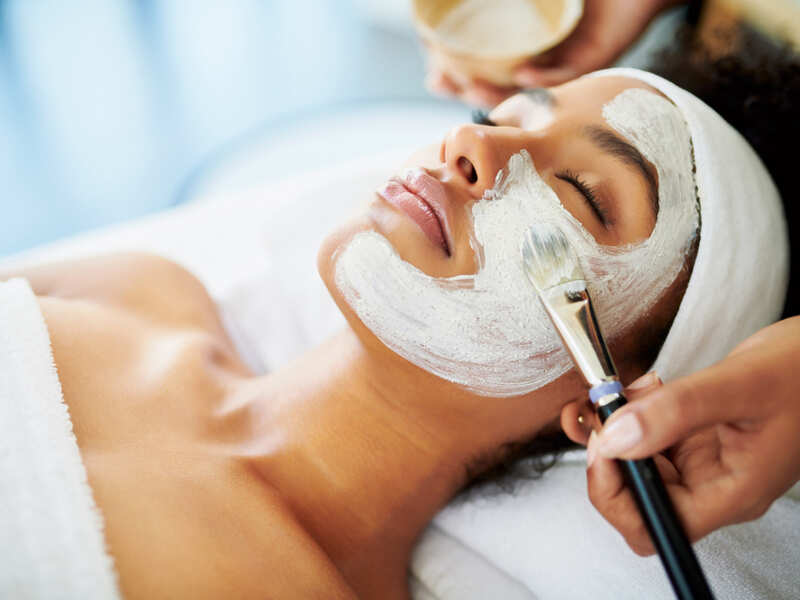What To Know About Chemical Peel Before And After
Chemical peels can be used to treat acne and other skin conditions, but they also have benefits for the appearance of your skin. Chemical peels are designed to remove the outermost layer of skin, which reveals younger, healthier skin underneath. The process is similar to how a sunburn heals—the top layers of your skin are removed, revealing healthier cells below.
Chemical peels are usually performed in a dermatologist’s office or by a licensed professional at a spa or salon. It’s important to follow the post-care instructions provided by your provider so that you get the most out of your treatment and avoid any complications.
Skin, it’s a funny thing. On the one hand, it protects our insides from all manner of external nastiness. It contains pores that sweat and organs that, um, don’t. And it plays host to all manner of adorable moles and good-looking freckles. But skin is also kind of a jerk to us the whole time we’re growing up. Allergies, acne, exfoliating dead skin cells – they’re all part of a daily skin-care routine you start before you even hit puberty. Read on to learn more Chemical Peel Recovery Time/No Peeling After Chemical Peel.

What To Know About Chemical Peel Before And After
Chemical peels may seem like a short and simple in-clinic lunch-time procedure, however, results may vary depending on what pre and post-peel care you are taking. Inappropriate care may either lead to dissatisfying results or side-effects like skin burn, sensitivity or worsening of your problems.
Things to do before going for a chemical peel
Prep your skin – Start using hydrating serums/moisturizers and sunscreens inadequate amount 2 to 3 weeks prior. Your dermatologist may also prescribe some products with glycolic acid, a bleaching agent like hydroquinone or retinoid 3 weeks prior to aid the peeling process and prep your skin.
Don’t do these one week before a peel – waxing, threading, epilating, depilating, hair reduction laser, at-home exfoliation, scrubs, hair dye.
History of recurrent cold sores – Dermatologist may prescribe a course of anti-viral drugs before the treatment.
Get yourself evaluated to check if you are not a candidate for peels – history of keloid, unusual pigmentation issue, current fungal infection, Pregnancy (certain peels are to be avoided if pregnant).
There should a gap of at least 3 weeks between two peels.
Post peel
Facewash – Avoid using a cleanser for 1 to 2 days
Moisturize your skin.
Slather yourself with Sunscreen – Use a broad spectrum physical or chemical sunscreen with SPF of 30 to 50 every 3 hours. Do not step out in direct sunlight.
Avoid Actives – Refrain from using retinoids, vitamin C, anti-acne products, other exfoliating agents like glycolic acid, salicylic acid and others for a minimum of 3 to 5 days post peel. Avoid for a week to 10 days in case of a deeper peel.
Avoid direct heat – No steam, sauna for a week post peel.
Avoid swimming for 5 days post peel.
Avoid – waxing, threading, epilating, lasers for hair reduction and other purposes, collagen-stimulating procedures/lasers for a week post peel.
Topical/Oral medications may be prescribed by the doctor post-peel as required.
A minimum of 6 to 8 peel sessions are generally required to treat any skin issue. Adequate pre and post-peel skincare routine make the peeling process flawless giving optimum results.
Chemical Peel Recovery Time
The depth of your peel also dictates the length of your recovery period. For light and medium peels, you’ll experience flaking and peeling skin for 4-7 days after your procedure. For a deep peel, you can expect to be recuperating for up to 2 weeks, with significant peeling as well as some swelling and redness.
Have you had an in-clinic chemical peel but didn’t experience any peeling afterwards?
Were you disappointed that the treatment hadn’t worked?
Don’t worry most people expect to have some peeling after a peel but it really depends on the condition of your skin at the time of chemical peel whether you peel or not.
Skin’s natural cycle
Our skin is in a constant renewal state and we shed our top layer on a daily basis. We shed very slowly, and as dead skin cells get washed or brushed away, we do not normally notice this. The cells are made deep in our skin and migrate to the surface to be shed. This process is quite quick in youth lasting about a four-week period extending to six weeks or longer as we get older. As the shedding slows down, so does the production of new cells leading to a build-up of a thicker layer of dead skin cells on the surface. Externally, this can give your skin a dull, dry appearance.
The cells also change as they migrate to the top from being juicy and plump to flatter and dehydrated. They normally carry pigment to the surface with them. Once at the surface they are held by special bonds which ‘glue’ the cells together for a short period before they break away.
What happens during a chemical peel?
During a chemical peel, a specially prepared acid or a combination of acid solution is applied on the surface of your skin. This breaks the bonds or ‘glue’ holding the cells together. Different acids are able to penetrate to different depths during the treatment. Over the following week, the cells separate away giving visible signs of flaking or peeling. Sometimes this may only be happening when you wash your skin so you may not be aware of the ‘peeling’. If the skin is particularly dehydrated at the time of the peel, you may experience more peeling. Deeper peels cause more extensive peeling.
Whether you peel or not, you can be reassured that a good chemical peel would do its job- stimulate separation of the surface layer encouraging your skin to multiply faster. Hence reveal more radiant, hydrated skin.
What are the risks of a chemical peel?
Occasionally if the skin is poorly prepared with no exposure to medical-grade products, it may react with side effects such as hyper (increased) pigmentation, inflammation or even scarring. It is possible to have an allergic reaction to the components of the peel in susceptible individuals. It is therefore recommended that your skin is prepared with the correct skincare before you have a chemical peel. This may be as little as two weeks or twelve to eighteen weeks depending on your risk factors. Those with a darker skin tone or a family history of darker skin tones are at increased risk of hyperpigmentation and need careful skin preparation.
What are the benefits of a chemical peel?
A chemical peel is a brilliant skin rejuvenation treatment to stimulate your skin to perform better. It is great at removing superficial pigmentation and improving superficial scars. By exfoliation, it can help to even out your skin tone. Chemical peels can be used to address uneven and rough skin texture by stimulating new skin production. It also helps to reduce fine lines and wrinkles as skin quality improves.
In blemish-prone skin, the targetted chemical peel helps to shrink the pore and reduce sebum production. It will also reduce inflammation leading to fewer blemishes.
How often should you have a chemical peel?
How often you should have a peel really depends on the intended purpose. For acne and blemish-prone skin, gentle chemical peels are recommended every 2-3 weeks. For pigmentation, it maybe every 3-4 weeks. Skin rejuvenation peels maybe every 4-6 weeks. Once a course of a peel is completed you should really start a maintenance programme to sustain the results of the initial treatment course. You may also consider home peels when clinic attendance is unsuitable. If not maintained, the skin will revert back to its dull state lacking lustre.
At Skin Enhance And Wellness, I offer a variety of chemical peels including prescription-only chemical peels. It is best to have a consultation first in person or remotely to assess suitability and start on home treatment to prepare for a chemical peel.

No Peeling After Chemical Peel
Chemical peels are a great way to improve the appearance of your skin. They can help with acne, fine lines and wrinkles, hyperpigmentation, and even remove sun damage. But not all chemical peels are created equal.
Chemical peels come in varying strengths and can be used on different areas of the body. The strength of the peel depends on how deep it penetrates into the skin’s layers. This process of removing dead skin cells is called exfoliation, which is necessary for healthy looking skin.
Chemical peels can be done in-office or performed in your doctor’s office as an outpatient procedure. The most common types are:
Glycolic acid (20-70%) : Glycolic acid is commonly used for superficial wrinkles and hyperpigmentation (brown spots). It’s also used to treat acne because it has antibacterial properties that help fight breakouts. It temporarily exfoliates the top layer of skin by removing dead skin cells, leaving behind newer, healthier ones that look smoother and more even toned. A glycolic acid professional peel will not cause any peeling or flaking after treatment because there isn’t enough acid in the formula to cause any peeling action on its own.
Chemical peel not peeling at home following treatment? No worries! It doesn’t mean the peel’s not working. In fact, the healing process will vary from person to person and day to day.
The journey to a great chemical peel starts with finding the kind of peel best suited for you. It ends with ensuring that your skin gets the best care after the peel.
What Is a Chemical Peel
A chemical peel is a way of exfoliating skin using a solution that has a pH of around two. It helps to smooth out the texture of the skin making your face feel fresh. It helps to treat many skin issues like hyperpigmentation, acne, and wrinkles.
Chemical Peel Side Effects
The side effects that you may experience depend mainly on the type of peel used, its strength, and intensity. For light peels, you will have little to no side effects. Usually, you will get a little redness which resolves in an hour or two.
For deep peels, you will have skin peeling in addition to the redness. Other side effects include the change of skin color, heart, kidney or liver damage, infection, and scarring. These effects can last for 7-10 days.
How to Care for Skin
Knowing the above, it is therefore important that you take care of your skin after a chemical peel. For at least 24 hours, it is important to ensure that you do not use products that have active ingredients like:
- Alpha Hydroxy Acids.
- Beta Hydroxy Acids.
- Low pH Serums.
- Retin-A or any other Retinoids.
- Serums with Vitamin C and Ascorbic Acid.
- Any other chemical exfoliates.
Follow a very bland and basic skincare routine. Use a hyaluronic acid product as they help to moisturize, hydrate, and play an important role in wound healing. Look for ingredients like ceramides and cholesterol which function as ingredients identical to those found in the skin. They help to repair damage caused to the moisture barrier.
A good moisturizer to use after a chemical peel is CeraVe. It comes with an addition of four percent niacinamide. Niacinamide is an antioxidant that has anti-aging benefits and helps to brighten skin tone. It also increases the production of collagen by your skin and is great for people with dry skin.